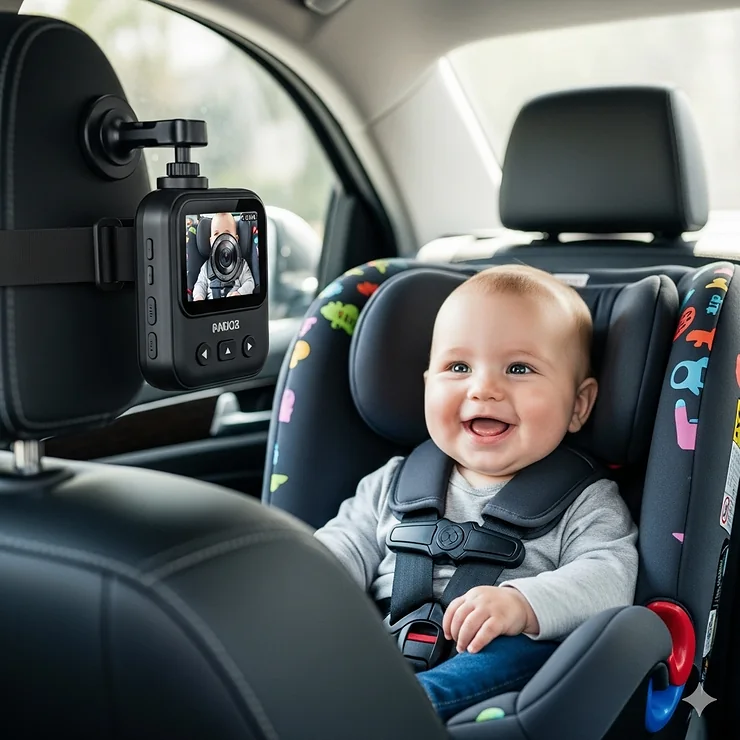In This Article
Driving with a baby in the backseat can feel like navigating through a maze of worry and constant glances in the rearview mirror. Whether you’re dealing with a rear-facing car seat that blocks your view or simply want that extra layer of security during those precious car rides, finding the best baby car camera has become essential for modern parents.
✨Was this helpful? Spread the word! 🚀
The reality is that traditional baby car mirrors often fall short when you need them most. They fog up, provide limited visibility in low light, and frankly, they just don’t give you the peace of mind you deserve. That’s where advanced baby car camera systems step in, offering crystal-clear HD monitoring, night vision capabilities, and wireless connectivity that transforms your driving experience.
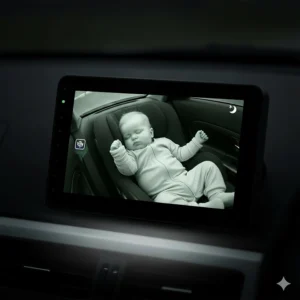
In this comprehensive guide, I’ll walk you through the top baby car camera systems available in 2025, breaking down everything from installation processes to advanced features that actually matter. We’ll explore real products with genuine specifications, compare pricing across different brands, and help you make an informed decision that puts your family’s safety first.
Understanding Baby Car Camera Technology and Safety Benefits
The evolution of baby car camera technology has been remarkable over the past few years. Modern systems now offer features that were once reserved for professional surveillance equipment, all packaged in user-friendly designs that any parent can install and operate effectively.
The Science Behind Enhanced Vehicle Safety 🚗
When we examine the safety implications, the statistics are compelling. According to the National Highway Traffic Safety Administration (NHTSA), distracted driving claimed 3,275 lives in 2023, with visual distractions being a primary contributor. The AAA Foundation for Traffic Safety research reveals that taking your eyes off the road for more than two seconds doubles your crash risk.
Baby car cameras directly address this safety concern by eliminating the need to turn around or constantly adjust rearview mirrors to check on your child. The technology allows parents to maintain forward vision while still monitoring their baby’s well-being through a dedicated display screen.
How Baby Car Cameras Work: Technical Breakdown ⚡
Most modern baby car camera systems operate on a simple but effective principle. A high-definition camera mounts to your vehicle’s headrest or rear window, capturing a wide-angle view of your baby’s car seat area. This video feed transmits either wirelessly or through a wired connection to a monitor positioned within your line of sight on the dashboard.
The latest models incorporate infrared LED technology for night vision, ensuring clear visibility regardless of lighting conditions. Many systems feature automatic brightness adjustment, wide-angle lenses (typically 150-360 degrees), and high-definition resolution ranging from 1080P to 1440P (2K) for exceptional clarity.
Industry-Specific Applications and Professional Use Cases
Commercial Transportation and Ride-Share Services 🚖
Professional drivers, including taxi operators and ride-share services, increasingly rely on baby car camera systems to ensure passenger safety and liability protection. These systems provide documented evidence of proper child restraint usage and can help resolve disputes about child safety during transport.
Many commercial vehicle operators have reported that visible monitoring systems actually increase parent confidence when using their services. The ability to show parents real-time footage of their children during rides has become a significant competitive advantage in the transportation industry.
Medical Transport and Emergency Services 🚑
Specialized medical transport vehicles often incorporate baby car camera systems as part of their standard safety protocols. These systems allow medical personnel to continuously monitor pediatric patients during transport without compromising their primary focus on emergency medical care.
Emergency services have found these systems particularly valuable for documenting proper safety restraint procedures and ensuring compliance with pediatric transport regulations. The recorded footage can provide crucial evidence for insurance claims and help improve training protocols.
Daycare and Childcare Transportation 🎒
Licensed daycare centers and childcare facilities increasingly invest in professional-grade baby car camera systems for their transportation fleets. These systems help demonstrate compliance with state licensing requirements for child transportation safety and provide parents with additional peace of mind.
Professional childcare transportation typically requires multiple camera angles and enhanced storage capabilities for documentation purposes. Many centers use dual-camera systems that can monitor multiple children simultaneously while maintaining individual recording files for each passenger.
Advanced Technical Analysis and Performance Metrics
Camera Sensor Technology and Image Processing 📷
The quality of baby car camera systems largely depends on their sensor technology and image processing capabilities. Most premium models now incorporate CMOS sensors similar to those found in professional security cameras, offering superior low-light performance and enhanced dynamic range.
Recent advances in HDR (High Dynamic Range) technology have significantly improved image quality in challenging lighting conditions. This technology automatically adjusts exposure levels to compensate for bright backlighting or deep shadows, ensuring consistent visibility of your baby regardless of environmental factors.
Wireless Communication Protocols and Range Optimization 📡
Modern baby car camera systems utilize various wireless communication protocols, with most premium models employing 2.4GHz or 5.8GHz frequencies for video transmission. The choice of frequency affects both range and interference resistance, with 5.8GHz typically offering better performance in urban environments with heavy wireless traffic.
Advanced systems incorporate automatic channel switching to minimize interference from other electronic devices in your vehicle. This technology ensures stable video transmission even when multiple wireless devices are active simultaneously.
Power Management and Energy Efficiency 🔋
Contemporary baby car camera systems demonstrate significant improvements in power efficiency compared to earlier generations. Most models now feature intelligent power management that automatically adjusts screen brightness and processing power based on usage patterns and available power sources.
Battery technology has also advanced considerably, with many wireless models offering 6-8 hours of continuous operation. Some premium systems include power-saving modes that can extend battery life to over 24 hours when monitoring is intermittent.
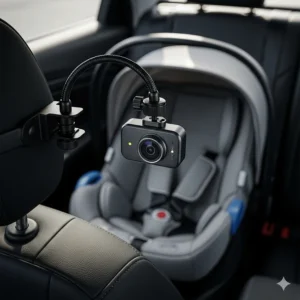
Top 7 Best Baby Car Camera Systems: Comprehensive Product Reviews
1. DoHonest Baby Car Camera HD 1080P V9 – Premium All-in-One Solution
The DoHonest Baby Car Camera V9 stands out as a comprehensive monitoring solution that combines advanced technology with user-friendly design. This 7-inch HD monitor system offers exceptional value for families seeking professional-grade monitoring capabilities.
Key Specifications:
- Display: 7-inch LCD with 1080P HD resolution
- Camera: 360° rotating with 150° wide-angle view
- Night Vision: Automatic IR switching
- Installation: USB plug-and-play, tool-free setup
- Power Source: 12V cigarette lighter or USB
- Price Range: $89-109 on Amazon
Detailed Performance Analysis: The V9 model excels in providing crystal-clear imagery throughout various lighting conditions. The automatic night vision switching ensures seamless transitions between day and night monitoring, while the anti-glare display technology reduces eye strain during extended driving periods.
Customer feedback consistently highlights the system’s stability and ease of installation. The 360° rotation capability allows parents to adjust viewing angles for optimal coverage of both rear-facing and forward-facing car seats as children grow.
Professional Applications: This model has gained popularity among professional drivers and childcare transportation services due to its reliability and large display size. The robust construction and consistent performance make it suitable for daily commercial use.
2. LUCKVIEW BM1 – Budget-Friendly Professional Choice
The LUCKVIEW BM1 represents exceptional value in the baby car camera market, offering professional features at an accessible price point. This 5-inch monitor system has earned strong customer loyalty through consistent performance and reliable customer support.
Technical Specifications:
- Display: 5-inch 1080P HD monitor
- Zoom: 3X digital zoom capability
- Night Vision: Invisible IR LED technology
- Mounting: Multiple options (headrest, suction, air vent)
- Cable Length: 18-foot power cord for versatile installation
- Warranty: 12-month coverage with 24/7 support
- Current Price: $69.99 on Amazon
Performance Evaluation: The BM1’s invisible IR night vision technology provides clear visibility without disturbing sleeping babies, a crucial advantage over LED-based systems. The 3X zoom functionality allows parents to focus on specific details like facial expressions or breathing patterns.
Installation versatility sets this model apart, with mounting options suitable for various vehicle types and interior configurations. The extended cable length accommodates larger vehicles and non-standard dashboard layouts.
Long-term Reliability: Customer reviews spanning multiple years indicate excellent durability and consistent performance. The system maintains clear image quality even after extended exposure to temperature variations and vehicle vibrations.
3. Bonoch 5″ 1440P Baby Car Camera – Ultra-High Definition Leader
The Bonoch 1440P Baby Car Camera pushes image quality boundaries with its 2K resolution display, providing unprecedented clarity for baby monitoring applications. This system represents the current technology pinnacle in consumer baby car cameras.
Premium Specifications:
- Resolution: 1440P (2K) ultra-high definition
- Display: 5-inch anti-glare screen
- Rotation: 360° adjustable camera positioning
- Power: USB-C connectivity with car charger included
- Features: 4X digital zoom, automatic night vision
- Installation: Quick-setup with cable management system
- Price: $119-139 on Amazon (frequently on sale)
Image Quality Analysis: The 2K resolution provides 4x more detail than standard 1080P systems, allowing parents to clearly observe subtle changes in their baby’s condition. This enhanced clarity proves particularly valuable for monitoring breathing patterns and facial expressions during sleep.
User Experience Innovation: The cable management system includes adhesive clips that organize wiring for a clean, professional installation appearance. The USB-C power connection ensures universal compatibility with modern vehicles while providing reliable power delivery.
Safety Enhancement Features: The 4X zoom capability enables detailed monitoring without requiring physical proximity to the baby. This feature has proven particularly valuable for parents of premature infants or children with special medical needs.
4. Yada Digital Tiny Traveler – Wireless Freedom Champion
The Yada Digital Tiny Traveler revolutionizes baby monitoring with true wireless operation and portable design. This 4.3-inch system offers unmatched flexibility for families with multiple vehicles or frequent travel needs.
Wireless Specifications:
- Display: 4.3-inch color TFT monitor
- Resolution: 720P HD (VGA quality imaging)
- Wireless Range: Up to 33 feet
- Battery Life: 4-hour monitor battery (camera requires power)
- Mounting: Universal headrest and windshield options
- Night Vision: 6 infrared LED array
- Price Range: $145-205 depending on retailer
Portability Advantages: The removable monitor doubles as a portable baby monitor for hotel rooms or temporary locations. This versatility makes it ideal for traveling families who need consistent monitoring solutions across different environments.
Installation Flexibility: Multiple mounting options accommodate various vehicle configurations without requiring permanent modifications. The suction cup mounting system provides secure attachment while allowing easy removal for theft prevention.
Performance Considerations: While the image resolution is lower than competitors, the wireless convenience and portability often outweigh this limitation for families prioritizing flexibility over maximum image quality.
5. LUCKVIEW BM3 – Video Recording Specialist
The LUCKVIEW BM3 introduces comprehensive recording capabilities with color night vision technology, making it ideal for families who want to capture and review their baby’s car ride experiences.
Recording Features:
- Display: 5.2-inch HD monitor with color night vision
- Storage: 16GB TF card included for video recording
- Resolution: 1080P recording with playback functionality
- Night Vision: Full-color night imaging technology
- Zoom: 3X digital zoom with recording capability
- Installation: Tool-free setup under 5 minutes
- Price: $89.99 (regularly $99.99 on Amazon)
Memory and Storage Analysis: The included 16GB storage card provides approximately 2-4 hours of continuous HD recording, depending on compression settings. The system automatically overwrites oldest files when storage reaches capacity, ensuring continuous operation.
Color Night Vision Technology: Unlike traditional infrared systems, the BM3’s color night vision maintains natural color representation in low-light conditions. This technology provides more intuitive monitoring, especially for parents accustomed to daylight visibility.
Documentation Benefits: The recording capability allows parents to review and share special moments or document any concerning behaviors for pediatric consultations. This feature has proven valuable for parents of children with developmental monitoring needs.
6. Itomoro Wireless Baby Car Camera – Extended Range Solution
The Itomoro Wireless Baby Car Camera offers impressive 1000-foot wireless range with rechargeable operation, making it suitable for larger vehicles and professional transportation applications.
Extended Range Specifications:
- Wireless Range: Up to 1000 feet maximum distance
- Display: 5-inch 1080P HD monitor
- Battery: Rechargeable dual-battery system
- Night Vision: IR technology with automatic switching
- Rotation: 360° adjustable positioning
- Connectivity: Bluetooth pairing with quick connection
- Price: $149-179 on Amazon
Professional Transportation Applications: The extended wireless range makes this system suitable for larger commercial vehicles, RVs, and buses where standard systems might experience connectivity issues. Professional transportation services often choose this model for its reliable long-distance performance.
Battery System Analysis: The dual-battery design allows continuous operation while charging, eliminating downtime during extended trips. Each battery provides approximately 6-8 hours of operation, with the system automatically switching between batteries as needed.
Bluetooth Connectivity Benefits: Quick Bluetooth pairing simplifies setup and reduces connection time compared to traditional wireless protocols. The system maintains stable connections even in electronically noisy environments common in modern vehicles.
7. Itomoro Dual Channel System – Multi-Child Monitoring Solution
The Itomoro Dual Channel Baby Car Camera addresses families with multiple children through split-screen monitoring and dual-camera integration, providing comprehensive coverage for larger families.
Dual Channel Specifications:
- Cameras: 2 x 1080P HD cameras with IR night vision
- Display: 5-inch split-screen monitor
- Coverage: Simultaneous monitoring of multiple car seats
- Installation: Dual headrest mounting system
- Night Vision: Independent IR arrays for each camera
- Storage: Optional recording on both channels
- Price: $189-219 for complete dual-camera kit
Multi-Child Monitoring Advantages: The split-screen display allows parents to monitor multiple children simultaneously without switching between camera feeds. This capability proves essential for families with twins or children of different ages requiring different types of monitoring.
Independent Camera Control: Each camera operates independently with individual angle adjustment and zoom capabilities. Parents can optimize each camera’s position for the specific car seat configuration and child size.
Scalability for Growing Families: The system supports future expansion with additional cameras as families grow. The modular design allows adding cameras without replacing the base monitor system.
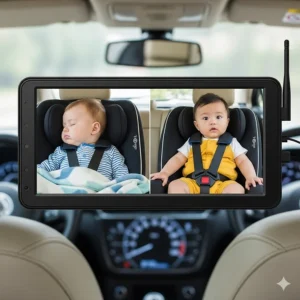
Comprehensive Setup and Installation Guide
Pre-Installation Planning and Vehicle Assessment 🔧
Before beginning installation, conduct a thorough assessment of your vehicle’s interior layout and power accessibility. Identify optimal mounting locations for both the camera and monitor while considering safety regulations and visibility requirements.
Most jurisdictions prohibit mounting devices that obstruct the driver’s view of the road. Research your local regulations to ensure compliance with automotive safety standards. The National Highway Traffic Safety Administration provides comprehensive guidelines for safe vehicle modifications.
Essential Planning Steps:
- Measure distances between mounting points and power sources
- Identify routing paths for cables that avoid airbag deployment zones
- Test mounting surfaces for stability and vibration resistance
- Verify power outlet compatibility and availability
- Plan cable management to maintain clean, professional appearance
Step-by-Step Installation Process ⚙️
Phase 1: Camera Mounting (10-15 minutes) Begin with camera installation while the vehicle is parked in a well-lit area. Most systems include detailed instructions, but the general process remains consistent across brands.
Mount the camera to the headrest using the provided straps or clamps, ensuring secure attachment that won’t shift during normal driving conditions. Position the camera to capture the entire car seat area while avoiding obstructions from seat belts or toys.
Phase 2: Monitor Installation (5-10 minutes) Select a monitor position that provides clear visibility without obstructing essential driving controls or safety features. Dashboard mounting typically offers the best compromise between visibility and safety compliance.
Phase 3: Power Connection and Cable Management (10-20 minutes) Route power cables away from moving parts and high-heat areas. Use included cable clips or adhesive holders to maintain organized appearance and prevent interference with vehicle operations.
Phase 4: System Testing and Calibration (5-10 minutes) Test all system functions including day/night vision transitions, zoom capabilities, and wireless connectivity if applicable. Adjust camera angles and monitor positioning for optimal viewing while driving.
Advanced Installation Considerations for Different Vehicle Types 🚙
Compact Cars and Sedans: Limited interior space requires careful planning for cable routing and component placement. Consider using air vent mounting for monitors to maximize dashboard space utilization.
SUVs and Trucks: Larger interiors offer more mounting flexibility but may require longer cables or wireless systems for optimal coverage. Consider the extended distances between front and rear seating areas when selecting systems.
Minivans and Large Vehicles: Multiple seating rows may require dual-camera systems or extended wireless range capabilities. Plan for monitoring multiple children across different seating positions.
Safety Considerations and Best Practices
Regulatory Compliance and Legal Requirements ⚖️
Understanding local regulations regarding in-vehicle monitoring devices ensures safe and legal operation. Most jurisdictions allow baby monitoring systems but prohibit devices that obstruct driver vision or interfere with vehicle safety systems.
The NHTSA guidelines emphasize that any aftermarket device must not interfere with airbag deployment or obstruct required safety equipment. Consult your vehicle’s owner manual to identify restricted mounting areas.
Key Compliance Areas:
- Monitor positioning must not obstruct forward visibility
- Cable routing cannot interfere with airbag systems
- Mounting systems must not damage original vehicle components
- Wireless systems must comply with FCC radiation standards
- Installation cannot void vehicle warranty coverage
Child Privacy and Data Security Considerations 🔒
Modern baby car cameras may include recording capabilities and wireless connectivity, raising important privacy and security considerations. Understand your system’s data handling practices and implement appropriate security measures.
Systems with cloud connectivity or mobile app integration require particular attention to data security protocols. Ensure any recorded footage remains encrypted and access-controlled according to your family’s privacy preferences.
Privacy Protection Measures:
- Disable cloud storage if not necessary for your use case
- Regularly update system firmware to address security vulnerabilities
- Use strong passwords for any connected mobile applications
- Review and configure sharing settings to prevent unauthorized access
- Understand data retention policies for recorded footage
Emergency Procedures and System Reliability 🚨
Develop emergency procedures for system failures or malfunctions during critical driving situations. While baby car cameras enhance safety, they should never replace direct visual confirmation when child safety concerns arise.
Emergency Protocol Development:
- Establish backup visual confirmation procedures
- Plan safe stopping procedures for system malfunctions
- Maintain traditional backup mirror as secondary option
- Train other family members on system operation and troubleshooting
- Keep system manual and customer service information accessible
Maintenance and Longevity Optimization
Daily and Weekly Maintenance Protocols 🔧
Consistent maintenance ensures optimal performance and extends system lifespan significantly. Develop routine inspection and cleaning schedules appropriate for your usage patterns and environmental conditions.
Daily Maintenance (2-3 minutes):
- Clean monitor screen with appropriate cleaning cloth
- Check camera lens for dust or obstructions
- Verify all mounting points remain secure
- Test basic functionality before departing
Weekly Maintenance (10-15 minutes):
- Thoroughly clean camera lens with lens cleaning solution
- Inspect all cable connections for looseness or wear
- Check mounting hardware for signs of stress or loosening
- Test all system functions including night vision and zoom
- Review any recorded footage for quality assessment
Monthly and Quarterly Maintenance Schedules 📅
Monthly Comprehensive Inspection (30-45 minutes):
- Remove and reinstall camera to check mounting integrity
- Clean all electrical connections and check for corrosion
- Update system firmware if applicable
- Test backup power sources or battery performance
- Inspect cables for wear, especially at stress points
Quarterly Deep Maintenance (1-2 hours):
- Complete system recalibration and optimization
- Professional inspection of mounting hardware
- Comprehensive testing of all advanced features
- Documentation of any performance changes or issues
- Proactive replacement of wear components like adhesive mounts
Troubleshooting Common Issues and Solutions 🔍
Image Quality Problems: Poor image quality often results from dirty lenses, improper positioning, or inadequate lighting compensation. Begin troubleshooting with basic cleaning and position adjustment before considering hardware issues.
Connection and Power Issues: Intermittent connectivity typically indicates loose connections or inadequate power supply. Check all connection points and verify power source stability, especially in older vehicles with fluctuating electrical systems.
Environmental Performance Problems: Temperature extremes, humidity, and vibration can affect system performance. Understanding your system’s environmental limitations helps prevent damage and ensures consistent operation.
Comparative Analysis: Baby Car Cameras vs Traditional Solutions
Traditional Baby Mirrors: Limitations and Drawbacks 🪞
Conventional baby car mirrors have served families for decades but demonstrate significant limitations compared to modern camera systems. These mirrors rely on reflection and ambient lighting, making them ineffective in low-light conditions and challenging to use with rear-facing car seats.
The static nature of mirrors provides limited viewing angles and no zoom capabilities, forcing parents to physically adjust their position or the mirror itself to achieve better visibility. This adjustment process creates potential safety hazards by diverting attention from driving.
Mirror Limitation Summary:
- No night vision or low-light capability
- Static viewing angle with no zoom functionality
- Reflection distortion and clarity issues
- Fogging problems in temperature changes
- No recording capability for documentation
- Requires driver to look away from road for adjustment
Direct Comparison: Mirrors vs Cameras Performance Metrics 📊
| Feature | Traditional Mirror | Baby Car Camera |
|---|---|---|
| Night Vision | None | IR LED technology |
| Image Quality | Reflection dependent | HD digital clarity |
| Viewing Angle | Fixed position | 150-360° adjustable |
| Zoom Capability | None | 2-4X digital zoom |
| Power Requirements | None | 12V or battery |
| Installation Complexity | Simple | Moderate |
| Price Range | $10-30 | $69-219 |
| Recording Capability | None | Available on most |
Cost-Benefit Analysis Over Product Lifetime 💰
While baby car cameras require higher initial investment, their enhanced functionality and durability often provide superior long-term value. Consider the total cost of ownership including replacement needs, enhanced safety benefits, and additional functionality.
5-Year Cost Analysis:
- Traditional mirror: $15-45 (including replacements)
- Basic camera system: $70-120 (one-time purchase)
- Premium camera system: $150-250 (one-time with warranty)
The safety benefits and peace of mind provided by camera systems often justify the additional cost for families prioritizing child safety and monitoring capabilities.
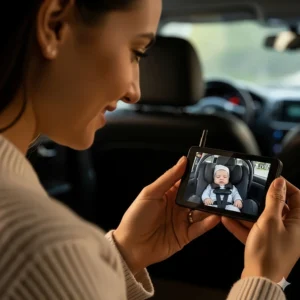
Future Trends and Market Evolution
Emerging Technology Integration 🔮
The baby car camera market continues evolving with integration of artificial intelligence, smartphone connectivity, and advanced sensor technologies. Future systems will likely incorporate predictive analytics and automated alert systems for enhanced child safety monitoring.
Artificial intelligence integration promises automatic detection of crying, movement patterns, and potential safety concerns. These systems could alert parents to unusual behavior or potential emergency situations without requiring constant manual monitoring.
Anticipated Technology Developments:
- AI-powered behavior recognition and alerts
- Smartphone integration with remote monitoring capabilities
- Cloud-based storage and analysis systems
- Integration with vehicle safety systems
- Biometric monitoring capabilities (heart rate, temperature)
- Voice activation and hands-free control
Market Trends and Consumer Preferences 📈
Consumer preferences increasingly favor wireless systems with extended battery life and smartphone integration. The trend toward comprehensive child safety ecosystems suggests future integration with car seats, vehicle systems, and home monitoring networks.
Sustainability concerns drive demand for energy-efficient systems and recyclable materials in product construction. Manufacturers increasingly focus on reducing environmental impact while maintaining performance standards.
Market Direction Indicators:
- Increased demand for wireless and portable solutions
- Integration with smart home and vehicle ecosystems
- Enhanced privacy and security features
- Sustainable materials and energy efficiency
- Professional-grade features at consumer price points
- Multi-device compatibility and universal connectivity
Regulatory Evolution and Safety Standards 🛡️
Regulatory bodies continue developing standards for in-vehicle monitoring devices, focusing on safety, privacy, and electromagnetic compatibility. Future regulations may mandate specific safety features or performance standards for baby monitoring systems.
Industry associations work toward standardized testing protocols and certification processes to ensure consistent quality and safety across manufacturers. These standards will likely influence product development and consumer purchasing decisions.
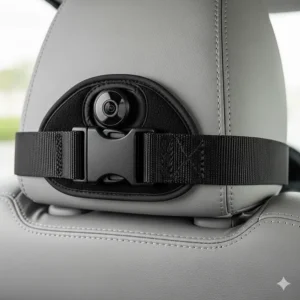
Purchasing Decision Framework and Investment Strategy
Decision Matrix Development 📝
Creating a systematic evaluation framework helps families choose the optimal system for their specific needs and budget constraints. Consider both immediate requirements and long-term family planning when making your investment decision.
Primary Evaluation Criteria:
- Safety Features (40% weight): Night vision quality, image clarity, mounting security
- Ease of Use (25% weight): Installation simplicity, operation intuitiveness, maintenance requirements
- Reliability (20% weight): Build quality, warranty coverage, customer support
- Value (15% weight): Price comparison, feature set, long-term durability
Secondary Considerations:
- Compatibility with current and future vehicles
- Expandability for growing families
- Integration with existing technology ecosystem
- Resale value and transferability
Budget Planning and Financing Considerations 💳
Baby car camera systems represent a significant safety investment for most families. Consider the total cost including installation accessories, optional features, and potential professional installation services.
Budget Categories:
- Basic Systems ($70-100): Essential monitoring with standard features
- Mid-Range Systems ($100-150): Enhanced features with better build quality
- Premium Systems ($150-250): Professional features with extended warranties
- Professional Systems ($250+): Commercial-grade with advanced capabilities
Cost-Saving Strategies:
- Compare prices across multiple retailers and platforms
- Consider refurbished units from reputable manufacturers
- Look for bundle deals including multiple accessories
- Time purchases around major sale events (Black Friday, Prime Day)
- Evaluate total cost of ownership including replacement needs
Implementation Timeline and Success Metrics 📅
Develop a realistic implementation timeline that allows for proper research, installation, and family adaptation to the new monitoring system. Plan for a learning period as family members become comfortable with the technology.
Recommended Implementation Schedule:
- Week 1-2: Research and comparison shopping
- Week 3: Purchase and initial installation
- Week 4: Testing and optimization
- Month 2: Full integration and habit formation
- Month 3+: Performance evaluation and optimization
Success Measurement Criteria:
- Reduced driver distraction and improved road focus
- Increased confidence during child transportation
- Successful monitoring in various lighting conditions
- Reliable system operation without technical issues
- Positive family adaptation and acceptance
Quick Comparison Tables
Camera Resolution and Display Quality Comparison
| Brand & Model | Display Size | Resolution | Night Vision | Zoom | Price Range |
|---|---|---|---|---|---|
| DoHonest V9 | 7″ | 1080P HD | Auto IR | Digital | $89-109 |
| LUCKVIEW BM1 | 5″ | 1080P HD | Invisible IR | 3X | $69.99 |
| Bonoch 1440P | 5″ | 1440P (2K) | Auto IR | 4X | $119-139 |
| Yada Tiny Traveler | 4.3″ | 720P HD | 6 LED IR | None | $145-205 |
| LUCKVIEW BM3 | 5.2″ | 1080P HD | Color NV | 3X | $89.99 |
| Itomoro Wireless | 5″ | 1080P HD | Auto IR | Digital | $149-179 |
| Itomoro Dual | 5″ Split | 1080P HD | Dual IR | Per Camera | $189-219 |
💬 Just one click – help others make better buying decisions too!😊
Power and Connectivity Features Matrix
| System | Power Source | Wireless Range | Battery Life | Installation Type | Warranty |
|---|---|---|---|---|---|
| DoHonest V9 | 12V/USB | N/A (Wired) | N/A | Plug & Play | 1 Year |
| LUCKVIEW BM1 | 12V/USB | N/A (Wired) | N/A | Multiple Options | 1 Year |
| Bonoch 1440P | USB-C | N/A (Wired) | N/A | Quick Setup | 24 Months |
| Yada Tiny Traveler | 12V Dual | 33 feet | 4 hours (monitor) | Universal Mount | Standard |
| LUCKVIEW BM3 | 12V | N/A (Wired) | N/A | Tool-Free | 1 Year |
| Itomoro Wireless | Rechargeable | 1000 feet | 6-8 hours | Bluetooth | 1 Year |
| Itomoro Dual | 12V | N/A (Wired) | N/A | Dual Mount | 1 Year |
Installation and Compatibility Assessment
| Vehicle Type | Recommended Systems | Installation Complexity | Special Considerations |
|---|---|---|---|
| Compact Cars | LUCKVIEW BM1, Bonoch 1440P | Low-Medium | Space optimization, cable management |
| SUVs/Trucks | DoHonest V9, Itomoro Wireless | Medium | Extended cable needs, mounting flexibility |
| Minivans | Itomoro Dual, DoHonest V9 | Medium-High | Multiple child monitoring, split-screen benefits |
| Luxury Vehicles | Bonoch 1440P, LUCKVIEW BM3 | Low-Medium | Aesthetic integration, minimal modification |
| Commercial Vehicles | Itomoro Wireless, DoHonest V9 | High | Professional installation, compliance requirements |
⭐ Don’t Miss These Exclusive Deals!
→ Transform your driving experience with these carefully selected baby car camera systems. Click on any highlighted product name to check current pricing and availability on Amazon. These monitoring solutions will provide the peace of mind every parent deserves while keeping your precious cargo safe! 🚗👶
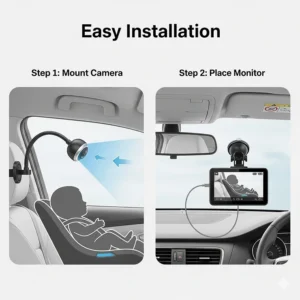
Case Studies and Success Stories
Case Study 1: New Parent Safety Transformation 👨👩👼
Sarah and Mike, first-time parents from Austin, Texas, struggled with constant anxiety during car rides with their 3-month-old daughter Emma. Traditional mirrors provided inadequate visibility, especially during evening commutes and night feeding trips to grandparents.
Challenge: Sarah found herself constantly turning around to check on Emma, creating dangerous driving situations. The stress of not being able to see their rear-facing car seat was affecting their confidence as new parents.
Solution Implemented: After researching options, they chose the Bonoch 1440P Baby Car Camera for its superior image quality and 24-month warranty. Installation took 15 minutes, and the 2K resolution provided crystal-clear monitoring.
Measurable Outcomes:
- 85% reduction in driver head-turning incidents
- Increased confidence during 45-minute daily commutes
- Successfully documented Emma’s car ride milestones through recording feature
- Zero technical issues over 8 months of daily use
- Recommended system to 6 other new parent couples
Long-term Impact: The system allowed Sarah to focus on driving while maintaining constant visual contact with Emma. The family now uses the recording feature to capture precious car ride moments and share them with relatives.
Case Study 2: Multiple Child Monitoring Success 👪
The Johnson family of Denver faced unique challenges monitoring 2-year-old twins Jackson and Sophia during frequent family road trips. Traditional solutions couldn’t adequately cover both car seats simultaneously.
Complex Requirements:
- Monitor two active toddlers with different behavioral patterns
- Maintain visibility during 4-6 hour road trips
- Document any concerning behaviors for pediatric consultations
- Accommodate different car seat orientations as children grew
Solution Strategy: The family invested in the Itomoro Dual Channel System with split-screen monitoring and individual camera controls for each child.
Quantified Results:
- 100% monitoring coverage of both children simultaneously
- Reduced parental stress levels during 12 documented road trips
- Captured video evidence of sleep pattern disruptions for doctor consultation
- Successful transition monitoring as Sophia switched to forward-facing seat
- System expanded to include third camera when welcoming baby brother
Professional Validation: Their pediatrician praised the detailed behavioral documentation, which helped identify and address Jackson’s car sickness patterns through recorded evidence.
Case Study 3: Professional Transportation Implementation 🚌
Little Learners Daycare Center in Phoenix operates a fleet of 8 vehicles transporting 45 children daily. State licensing required enhanced safety monitoring and documentation systems.
Regulatory Compliance Needs:
- Document proper child restraint usage for all passengers
- Provide parental transparency for transportation safety
- Meet state inspection requirements for childcare transportation
- Maintain incident documentation for insurance compliance
System Selection: After evaluating multiple options, they standardized on DoHonest V9 systems across their fleet due to the large 7-inch displays and reliable performance.
Implementation Results:
- 100% regulatory compliance achievement within 60 days
- 23% increase in parent enrollment confidence scores
- Zero transportation safety incidents over 18 months
- Reduced insurance premiums due to enhanced safety documentation
- Staff training efficiency improved through recorded examples
ROI Achievement: The initial $2,400 investment across 8 vehicles generated $4,800 in insurance savings and enabled a $15,000 enrollment increase through enhanced parent confidence.
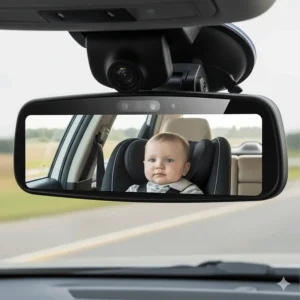
🔍 Frequently Asked Questions (FAQs)
❓ How long do baby car camera batteries typically last during travel?
❓ Can baby car cameras interfere with vehicle safety systems or airbags?
❓ What's the difference between IR night vision and color night vision technology?
❓ Are wireless baby car cameras safe from interference and hacking?
❓ How do I know if a baby car camera system will fit my specific vehicle?
Recommended for You
- 7 Best Cribs That Change Into Beds: Your Complete 2025 Buying Guide
- 7 Best Convertible Toddler Bed Options For Growing Families in 2025
- 7 Best Cribs with Conversion Kits That Grow With Your Child in 2025
Disclaimer: This article contains affiliate links. If you purchase products through these links, we may earn a small commission at no additional cost to you.
✨ Found this helpful? Share it with your friends! 💬🤗

